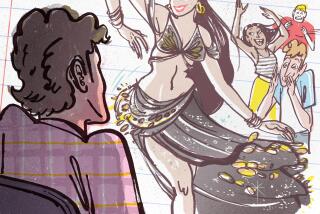Recalling a Class ‘Alive With Sound of Learning’
- Share via
In writing about Gonzalo Javier’s idea for a National Teachers Hall of Fame, I touched the memories of several former students, including my one-time colleague David Soibelman.
Soibelman belongs in some Hall of Fame himself. He is now 86. I knew him when we worked together on the old downtown Daily News. He covered City Hall. When the News folded in December, 1954, Soibelman went to work for City Hall as its public relations director. He achieved a kind of glory for the soaring, poetic, biblical handouts he used to write for the annual Christmas lighting of the cross in the City Hall tower. Alas, this custom was outlawed by the Supreme Court as a religious intrusion into government, and Soibelman fell silent. He retired 16 years ago at 70.
Soibelman was a product of Buffalo public schools. He began his newspaper career on the hometown Buffalo Evening News. He has sent me a clipping from the News of June 14, 1961, graduation week, in which he recalled the teachers who had guided him to his own graduation in 1917.
“And they (the graduation preparations) evoke memories of my graduation and last days in old Spruce Street School 12, the dedicated teachers of my youth, and the building that housed us all, the yard in which we played, but, above all, the teachers. To them, this bouquet, with love.
“Who still lives of those devoted teachers who fashioned the minds and gave perception to the boys and girls of the graduating class of 1917? Are their silver-haired days of retirement golden with the sunlight of public remembrance?”
Soibelman recalled that the Spruce Street School had no auditorium, no gymnasium, no playground, no lawn. It was purely functional. It had three floors of classrooms, hallways, cloakrooms and narrow stairways. The basement was used for exercising. (“How can you call it a gymnasium when it had no apparatus?”)
“In blizzards and rainstorms,” Soibelman recalled, “it was a damp but secure place to eat the lunch we had brought from home--and to contemplate mischief.”
One paragraph eulogizes a favorite teacher, Louise Villiaume. It is reminiscent of Soibelman’s most eloquent City Hall handouts: “Miss Villiaume’s room was alive with the sound of learning. She opened the window onto the wonderful world of ancient history, taught us the implacability of the algebraic rules, the mystical magic of the making of words, the laws of grammar to make speech and writing concise and clear, and the unflagging constancy and rightness of spelling, and the lessons in civics that made those of us who had sprung from a foreign soil proud of the land we chose as home.
“But next in remembrance to the love she exemplified was Miss Villiaume’s quality of the inspiration, gently prodding us to do better, to ‘use your minds to the fullest’ and to learn for the sake of learning. . . .”
Soibelman’s peroration could be taken as an endorsement of Javier’s idea for a Hall of Fame:
“It is time, ‘tis true, for a tribute to the teachers who take man by the hand and walk with him from the darkness of unawareness into the shining light in the glade among the apple trees of knowledge and truth and beauty and a good life.”
I read only the other day about a professor at Harvard deploring the fact that his students don’t read. They regard books as a waste of time. It is not hard to see why. Everything they know or think they know comes from television. Why should they bother to read?
How TV pervades our lives is reported in “TV Comes of Age,” a summary of the tube’s influence, in the September Connoisseur. It says that by the time they are 18, American children have seen 350,000 commercials; by the age of 16, they have seen 18,000 murders; by the time they finish high school (if they do), they have spent more time watching TV than doing anything else but sleeping. Percentage of Americans who get all their information about the world from television: 70.
You don’t get that kind of an education by reading “Ivanhoe,” or even “Catcher in the Rye.”
I’m not suggesting that children who are educated by TV are entirely ignorant, but they will never know the difference between toe and tow , shone and shown , or phase and faze .
More to Read
Sign up for Essential California
The most important California stories and recommendations in your inbox every morning.
You may occasionally receive promotional content from the Los Angeles Times.










